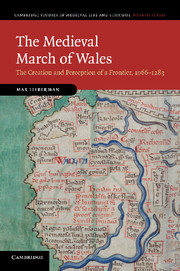Book contents
- Frontmatter
- Contents
- List of maps
- List of tables and illustration
- Preface
- List of abbreviations
- INTRODUCTION
- 1 A BORDER REGION?
- 2 THE MAKING OF A BORDER ARISTOCRACY
- 3 WARFARE AND DIPLOMACY
- 4 THE EXTENT AND NATURE OF THE MILITARY FRONTIER
- 5 THE MILITARIZATION OF SOCIETY
- 6 THE SHAPING OF ADMINISTRATIVE TERRITORIES
- 7 THE BORDER LORDSHIPS AND THE ENGLISH STATE
- CONCLUSION
- Select bibliography
- Index
6 - THE SHAPING OF ADMINISTRATIVE TERRITORIES
Published online by Cambridge University Press: 06 July 2010
- Frontmatter
- Contents
- List of maps
- List of tables and illustration
- Preface
- List of abbreviations
- INTRODUCTION
- 1 A BORDER REGION?
- 2 THE MAKING OF A BORDER ARISTOCRACY
- 3 WARFARE AND DIPLOMACY
- 4 THE EXTENT AND NATURE OF THE MILITARY FRONTIER
- 5 THE MILITARIZATION OF SOCIETY
- 6 THE SHAPING OF ADMINISTRATIVE TERRITORIES
- 7 THE BORDER LORDSHIPS AND THE ENGLISH STATE
- CONCLUSION
- Select bibliography
- Index
Summary
The honors on the Shropshire borders, like the Norman and English conquest lordships in Wales, were compact seigneurial territories. Accordingly, the perceived similarities between the two may well not have been limited to the military sphere. Certainly both military and ‘civilian’ elements inform the modern historical category of the March of Wales, for instance when summarized as ‘the area defined by the military enterprise and seigneurial power of the Anglo-Norman lords in the two centuries or so between 1066 and 1284’. The lords of the border honors and conquest lordships rightly saw themselves as military leaders, but their impact extended beyond what could be achieved by the sword. In the longer term, the purpose of military conquest was exploitation of land and of men for the lord's profit. There were various means to achieve that end in the twelfth and thirteenth centuries, but the lords of the Shropshire borderlands faced the distinctive challenge of finding ways to rule both the English and the Welsh population of their honors. How far did the lords' efforts at securing administrative, fiscal and judicial control over their lordships create distinctive administrative territories? And might this have contributed towards setting the borderlands apart from both Shropshire and Powys, while rendering them more similar to the conquest lordships in Wales?
- Type
- Chapter
- Information
- The Medieval March of WalesThe Creation and Perception of a Frontier, 1066–1283, pp. 189 - 217Publisher: Cambridge University PressPrint publication year: 2010



